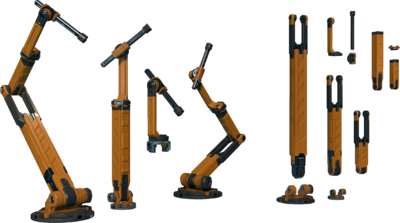Difference between revisions of "Robotic arms"
Jump to navigation
Jump to search
| Line 1: | Line 1: | ||
{{Otherlang2 | {{Otherlang2 | ||
|ru=Роботизированные | |ru=Роботизированные манипуляторы | ||
}} | }} | ||
== Summary == | == Summary == | ||
Revision as of 14:20, 18 August 2019
Summary

Robot arms are chain of hinges connected to a special turret joint body.
Robot arms have mostly the same functionality properties as hinges.
Robot arms are primarily used in factories for the operation of automated tools and factory lines.
Robot arms are also equipped adapters that allow the attachment of hardpoints into them to be used with turrets.
Basic information
- Robot arms consist of two types of joints, revolute and prismatic, which can be stacked together to form articulated arms of varying complexity.
- The basic arm configuration has one or two telescoping segments, and an end segment with a revolute joint. More arms or tool holders can be attached to this revolute joint.
- The base of any arm combination has to be attached to a special turret base joint.
- There are four different sizes of the basic arm.
Videos
Device fields
To learn more about how to use fields, consult these wiki pages:
| YOLOL field | description | range |
|---|---|---|
| TargetArmLength | Telescoping arm target length | [0,100]: percent of maximum extension |
| CurrentArmLength | Current arm length updated during arm movement | [0,100]: percent of maximum extension |
| EndPosition | Extension at maximum arm length | |
| StartPosition | Extension at minimim arm length | |
| TargetVelocity | Target velocity of telescoping movement |
| YOLOL field | description | range |
|---|---|---|
| TargetArmAngle | Rotating joint target angle | [-180,180]: degrees |
| CurrentArmAngle | Rotating joint current angle updated during arm rotation | [-180,180]: degrees |
| MaxRotation | Maximum rotation | |
| MinRotation | Minimum rotation | |
| TargetVelocity | Target velocity of rotation |